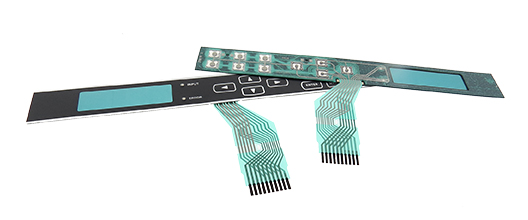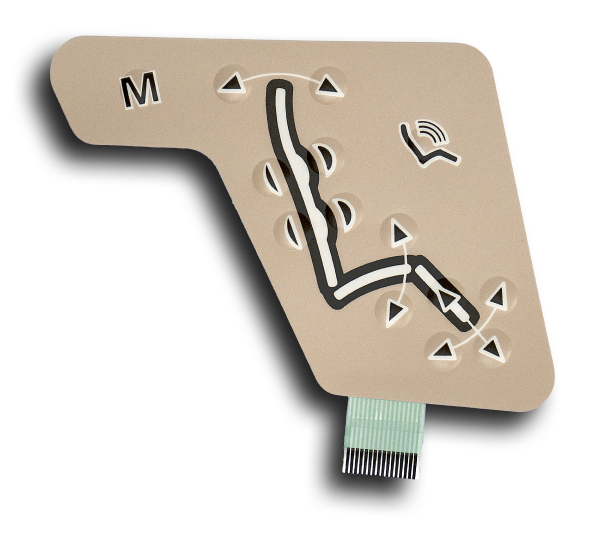Comprehending the Relevance of Membrane Layer Switch in Modern Electronics
Membrane switches are integral parts in modern digital gadgets. They offer a mix of capability and layout that boosts customer interaction. Their lightweight and sturdy nature makes them appropriate for numerous applications. As markets evolve, the demand for modification and advanced functions expands. Recognizing exactly how membrane changes add to advancement reveals their importance fit the future of electronic devices. What exists ahead for this modern technology?
The Essentials of Membrane Layer Switch Over Innovation
Although often overlooked, membrane layer switch technology plays a vital duty in the contemporary electronics landscape - membrane switch. These tools, composed of multiple layers, function as customer interfaces for numerous electronic items, varying from house home appliances to clinical tools. A common membrane layer switch is composed of a visuals overlay, a spacer layer, and a circuit layer, which are thoroughly constructed to produce a useful interface.When pressure is put on the overlay, the circuit layer is completed, allowing signals to be sent to the tool. This technology is understood for its convenience, making it possible for modification in form, style, and performance to satisfy particular customer requirements. Additionally, membrane layer buttons are thin and lightweight, making them ideal for applications where space is a premium. Their resilience and resistance to ecological factors additionally enhance their allure, guaranteeing they can stand up to extreme problems while keeping functionality. In general, membrane layer button modern technology is integral to developing easy to use and efficient digital gadgets

Key Advantages of Membrane Switches Over
Membrane changes offer numerous vital advantages that make them a recommended option in various digital applications. Their design permits for a portable kind aspect, making it possible for suppliers to develop lightweight and streamlined devices. Furthermore, membrane switches are resistant to dirt, moisture, and chemicals, which improves their durability and long life sought after atmospheres. The responsive responses offered by these buttons can boost individual experience, making them very easy and user-friendly to operate.Furthermore, membrane layer switches can be tailored with diverse graphics and shades, enabling distinct branding possibilities. The production process is normally cost-efficient, specifically for high-volume production, as it reduces assembly time and simplifies style. Membrane layer switches over need marginal upkeep, contributing to lower general operational prices. These benefits highlight their expanding popularity in contemporary electronics, where integrity and easy to use user interfaces are vital.

Applications Throughout Different Industries
The flexibility of membrane layer switches enables their prevalent adoption throughout different markets. In the medical field, they are commonly used in diagnostic devices and patient monitoring systems, using a sturdy user interface immune to impurities. The automotive industry utilizes membrane layer switches for dashboard controls, improving user experience with smooth layouts that withstand harsh conditions. In consumer electronics, they work as control panels for tools such as microwaves and coffee machine, offering an user-friendly user interface that is easy to tidy. The aerospace sector uses membrane buttons in cabin controls, where dependability and room efficiency are extremely important. Additionally, the commercial sector leverages these switches in equipment and control systems to assure durable operation popular settings. This wide variety of applications highlights the adaptability of membrane switches, making them important parts in enhancing performance and individual interaction across varied technological landscapes.
Modification and Layout Adaptability

Future Fads in Membrane Layer Change Advancement
Arising fads in membrane switch growth show a growing emphasis on enhanced functionality and assimilation with clever modern technologies. As consumer demand for much more innovative digital devices boosts, suppliers are concentrating on creating membrane layer switches over that not only serve standard see this here operational roles however also integrate attributes like touch level of sensitivity, backlighting, and haptic feedback.Furthermore, advancements in products are anticipated to improve longevity and ecological resistance, making membrane layer switches ideal for varied applications in industries such as health care, auto, and customer electronics. The assimilation of capacitive touch modern technology is likely to become a lot more widespread, permitting for sleeker designs and enhanced customer interfaces. membrane switch.Additionally, the why not try this out surge of the Net of Points (IoT) is prompting the advancement of membrane layer changes that can interact wirelessly with other tools, enhancing interconnectivity. Generally, the future of membrane button innovation appears promising, driven by advancement and the search of easy to use options
Often Asked Concerns
Just How Do Membrane Layer Switches Compare to Conventional Mechanical Buttons?
Membrane layer buttons, being more space-efficient and supplying a streamlined design, contrast with standard mechanical buttons that provide responsive comments. The previous often feature adjustable graphics, while the last commonly guarantee durability and integrity in different applications.
What Products Are Commonly Utilized in Membrane Switch Production?
Membrane layer switches are typically generated making use of materials such as polyester, polycarbonate, and printed conductive inks. These products give resilience, responsiveness, and flexibility, making them suitable for numerous applications in digital gadgets and customer interfaces.
Can Membrane Changes Be Repaired or Reused?
Membrane layer switches can frequently be fixed, particularly if small issues arise, such as sticky failing or surface damage. Full reuse is usually restricted due to wear and prospective degradation of products over time.
How Do Environmental Aspects Influence Membrane Layer Switch Performance?
Environmental elements, such as direct exposure, moisture, and temperature level to chemicals, significantly affect membrane layer button performance. Extreme problems can result in destruction, influencing responsiveness and longevity, eventually jeopardizing the functionality of the device in numerous applications.
What Is the Normal Life Expectancy of a Membrane Change?
The normal life-span of a go to website membrane layer switch normally ranges from 1 to 5 million actuations, depending on elements such as use regularity, environmental problems, and the products made use of in production, impacting longevity and efficiency longevity. A common membrane switch is composed of a visuals overlay, a spacer layer, and a circuit layer, which are thoroughly assembled to produce a useful interface - membrane switch.When pressure is applied to the overlay, the circuit layer is completed, permitting signals to be sent to the tool. The tactile responses offered by these buttons can boost customer experience, making them intuitive and very easy to operate.Furthermore, membrane layer buttons can be personalized with varied graphics and colors, enabling for special branding chances. As consumer need for more sophisticated digital devices boosts, makers are focusing on developing membrane layer switches that not just serve standard functional roles however also integrate functions like touch level of sensitivity, backlighting, and haptic feedback.Furthermore, advancements in materials are anticipated to improve toughness and environmental resistance, making membrane layer switches over appropriate for diverse applications in sectors such as health care, auto, and consumer electronic devices. The integration of capacitive touch modern technology is likely to end up being more common, enabling for sleeker designs and improved customer interfaces.Additionally, the surge of the Net of Things (IoT) is motivating the growth of membrane layer changes that can interact wirelessly with other gadgets, boosting interconnectivity. Membrane buttons, being more space-efficient and offering a streamlined design, comparison with typical mechanical switches that offer tactile responses
Comments on “What engineers need to know about membrane switch for medical systems”